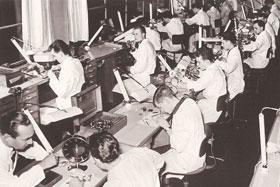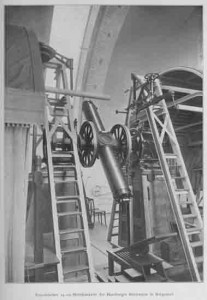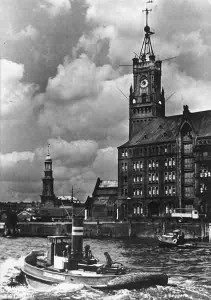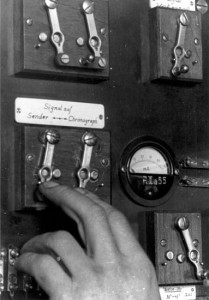 Being specialized in exclusive mechanical timepieces we carry on the venerable tradition of the Hanseatic city of Hamburg.
Being specialized in exclusive mechanical timepieces we carry on the venerable tradition of the Hanseatic city of Hamburg.
Even centuries ago Hamburg was a prime address for accurate and reliable chronometers. Ships chronometers, nautical instruments that were needed for exact navigation, were made down at the waterfront. Captains, discoverers and and explorers like the great Alexander von Humboldt relied on their Hamburg watchmakers. It is this spirit that lives on in the wristwatches of the HENTSCHEL HAMBURG UHRENMANUFAKTUR. Every single one of its timepieces is an ambassador of Hamburg watchmaking tradition.
Like in the times of Humboldt we still manufacture on request and every screw, wheel or Chaton goes through the able hands of our passionate watchmakers. Exquisite unique timepieces are coming from their work benches, noble, handmade watches with clear cut lines and aestethics that remind one of the great nautical instruments that were their precursors. Still the epitome of beauty, reliability and permanence.
 The Hanseatic city of Hamburg is connected to commerce and maritime shipping since time immemorial. With the establisment of the Hanseatic League in the 13th. century Hamburg became one of the major ports of Europe.
The Hanseatic city of Hamburg is connected to commerce and maritime shipping since time immemorial. With the establisment of the Hanseatic League in the 13th. century Hamburg became one of the major ports of Europe.
Nautical shipping made many watch and clockmakers settle in Hamburg.
The most famous among them – chronometer manufacturer Johann Heinrich Kessels – learned his trade from no other than A. L. Breguet. One of his trademarks is the small seconds dial at 06:00 h.
As a Hommage to him all hand wound recieved this technical characteristic.
The Hamburg watchmakers school was founded on April 28th. 1878, three days before Glashütte and is one of the oldest watchmaking schools of Germany. It was there where my watchmakers and I learned our trade.

Meridian circle
The origin of time
The determination of time was traditionally the most important task of the Hamburg astronomers. This was conducted at the observatory with the meridian circle which is a very precise telescope that tracked and measured the movment of the stars. For a long time the Hamburg transit instruments were regarded as the most accurate in the world among astronomers.
On earth we live in solar time. It derives from the ecliptic orbit of earth around the sun. The origin of our time thus lies in the stars and the determination of time is carried out by the exact measuring of the constant movements of the stars in our night sky. The apparent movement of the stars is a result of earth´s own rotation.

The “Timeball” in the port of Hamburg
The keepers of time
In addition to determining time at the Sternwarte Hamburg (the Hamburg observatory) the most important task was to keep the exact time by using extremely accurate clocks. These precision pendulum clocks are the keepers of time and those from Hamburg are still considered to be the best of the world. To manufacture and service these technical masterpieces one needed extraordinary skills. Because of this the Hamburg school of watchmaking was founded in 1871. It was here where the knowledge of Hamburgs chronometer makers was handed down to talented young watchmakers – in the city of Hamburg and in Glashuette/Sa. as well. The first headmaster of the simultaniously founded watchmakers school in Glashuette/Saxony was from Hamburg.
Dessimination of time
A common time is taken for granted these days. But this technological and logistical tour de force has its roots in Hamburg and is closely connected to the tradition of the Hanseatic city. Shipping and overseas trade made Hamburg a metropolis of clockmaking which was at times home for more chronometer makers than the watchmaker city of Geneva in Switzerland.
With the foundation of the Deutsches Reich in 1871 the German Kaiser and the Hamburg shipping companies decided for an independent time determination and chronometer production of the highest standard and to provide the financial means to achieve this. Together they established four Hamburg institutions:

The Hamburg “Timeball”
The history of chronometry is tightly linked to the success story of the Hanseatic city of Hamburg. With the ever increasing overses trade and number of emigrants at the end of the 19th. century the demands of the mechant navy were growing too. One crucial dimension for navigation was the exact time. For a specific localisation at sea the chronometers would have to keep their time after being adjusted to the second in the home port. Radio beacons or timesignals over the phone were still unkown back in these days. Because of this many harbour towns installed so called “timeballs” on prominent spots in their ports. Hamburg decided in 1876 to install such a device on the roof of the “Kaiserspeicher 1” (Kaiser storehouse 1) were the new opera house is today. To operate the timeball an underground electrical cable lead to the observatory outside the city.
Since 1876 the timeball fell at the push of a button (from 1899 onwards even automatically through contacts on a clock) precisely at 12 o´clock Greenwich time. 10 minutes to 12:00 it was raised to half-mast and 3 minutes to 12:00 fully to the top to display a clear signal for the captains who were watching from their ships.

Time service (Zeitdienst)
The determination of time was executed in the observatory with the meridian circle and the “time service” was traditionally one of the most important duties of the Hamburg astronomers.
The electrical contact clockwork at the observatory operated the Hamburg central time and the timeballs in the ports of Hamburg, Bremerhaven, Cuxhaven and the “speaking clock” on the phone. Two additional public time displays were controlled from there too, one directly at the observatory, the other one since October 1876 at the Hamburg stock exchange.
Starting in 1917 from the Hamburg observatory and later directly from the Hamburg Naval Institute the German central time (Deutsche Zentralzeit / Zeitdienst) was broadcasted. The trigger clocks in Hamburg were delivering such a precise signal that the daily adjustment was within several hundredth of a second.
The determination of time and broadcasting of the time signal was carried out until 1986.